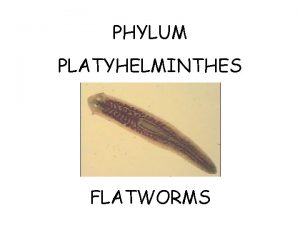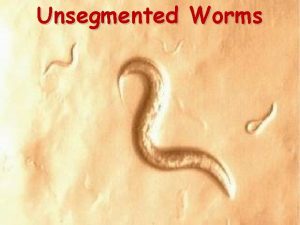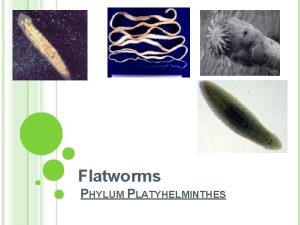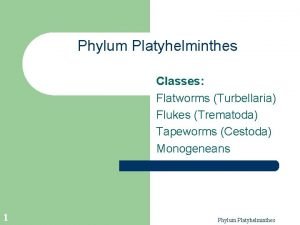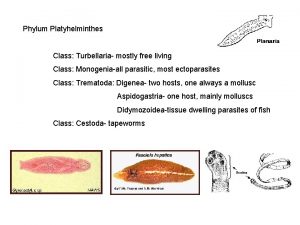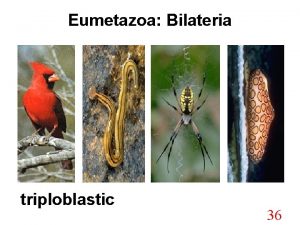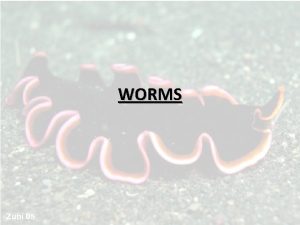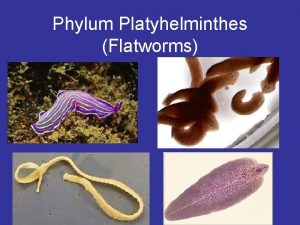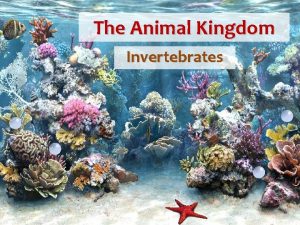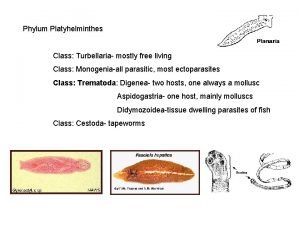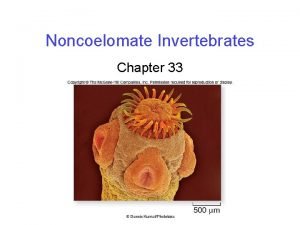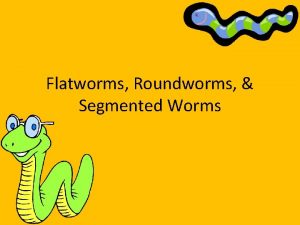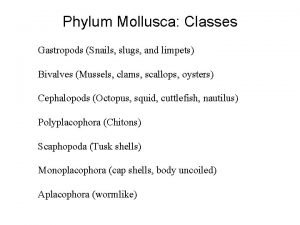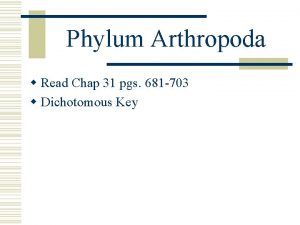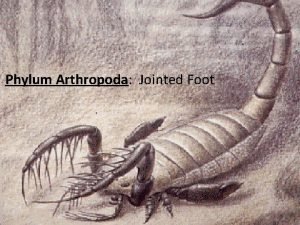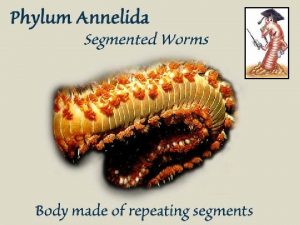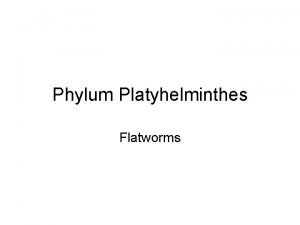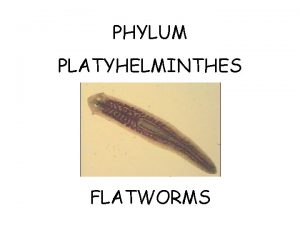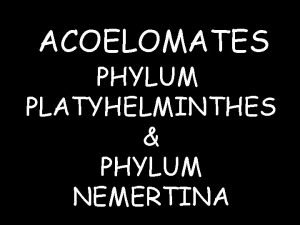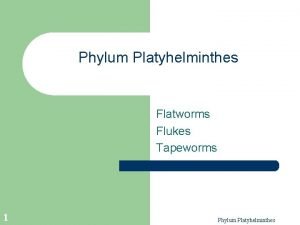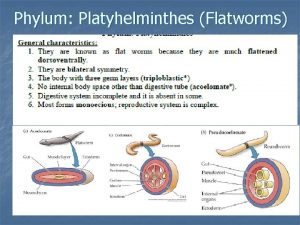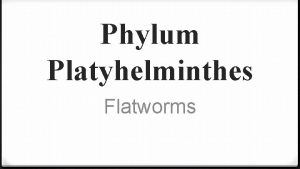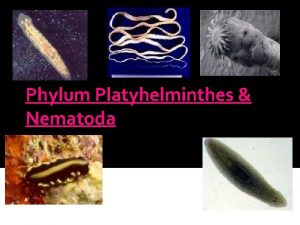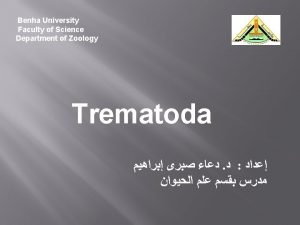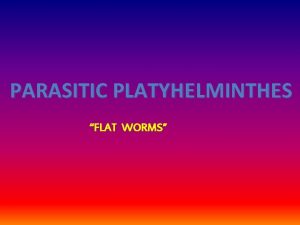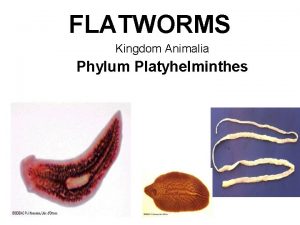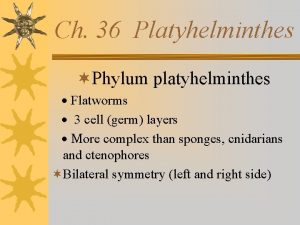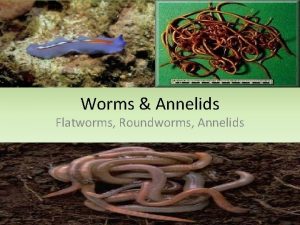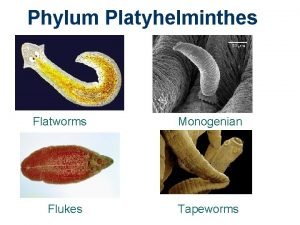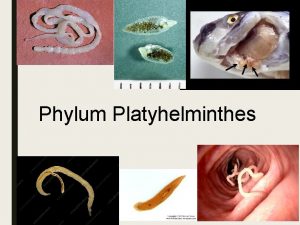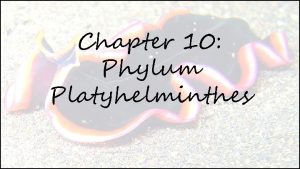PHYLUM PLATYHELMINTHES FLATWORMS Review Three classes in Phylum





















- Slides: 21

PHYLUM PLATYHELMINTHES FLATWORMS

Review: Three classes in Phylum Platyhelminthes a) Class Turbellaria: free-living flatworms (planarians and marine species) b) Class Trematoda : parasitic flukes c) Class Cestoda: parasitic tapeworms

1. Common name- flukes 2. Endoparasitic- live inside host 3. Wide, flat with oval or elongate bodies 4. Have 2 -3 hosts 1. Intermediate hosts- where asexual part of life cycle occurs 2. Definitive host- final host where sexual part of life cycle occurs 5. Almost all adult flukes are parasites of vertebrates (fish, frogs, turtles, livestock, and humans) 6. Internal anatomy is similar to Turbellarians (planarians).


1. Types: a. Chinese liver fluke- common parasite of humans that live in Asia. b. Sheep liver fluke- common in sheep or people who raise sheep 2. Lives in the liver where it eats tissue & blood. 3. Contracted by a. Eating uncooked contaminated food (sushi) b. Eating water plants (water cress) infected with larvae

4. Signs & Symptoms: • Enlarged liver • Feeling of fullness • Abdominal discomfort • Jaundice • Fatigue • Weakness • Nausea • Weight loss 5. Detection: look for eggs in stool or larvae in blood 6. Treatment: triclabendazole

1. Eggs passed out w/feces 2. Eggs ingested by a snail- the first intermediate host. a. Inside the snail, the eggs undergo asexual reproduction & metamorphosis 1. Miracidia- cilia for swimming 2. Sporocysts- asexual reprod. 3. Rediae- worm like stage 4. Cercariae- has tail for swimming 3. Free swimming cercariae burrow out of skin of snail and search out fish or plant- the second intermediate host. 4. Cercariae encyst in fish/plant and are called metacercariae which is then ingested by a human or other vertebrate. 5. Metacercariae excyst in the intestine and migrate to the liver where they live, feed & reproduce sexually.

Fluke Life Cycle

CLASS TREMATODA EX: Blood Flukes 1. Common in Africa, Asia, S. America 2. Cause disease known as Schistosomiasis (A. K. A. bilharzia) 3. Symptoms: • Fever & chills • lymph node enlargement • liver and spleen enlargement • frequent urination, blood in urine and in stool • Invasion in skin may cause rash (swimmer’s itch)

Blood Flukes- Schistosomes a. Blood flukes common in Africa, Asia, S. America b. Cause disease known as Schistosomiasis or bilharzia

CLASS CESTODA 1. 2. 3. 4. 5. Common name: tapeworms Endoparasitic: live inside host Long, flat ribbon-like bodies White w/shades of yellow or gray Size: 1 mm to 15 m in length (up to 60 ft!)

6. Body Structure a. Scolex- head-like structure; hooks & suckers for attachment (not feeding) b. Neck- contains immature proglottids- series of repeating units of reproductive organs. c. Strobila- rest of body; contains proglottids that are mature and gravid- full of eggs.


7 . Digestion a. No mouth or digestive tract. b. Absorb nutrients directly across their body wall.

8. Signs/Symptoms: • Nausea & Weakness • Loss of appetite • Weight loss & diarrhea • Inadequate absorption of nutrients in food • Can lead to Cysticercosis disease in humans where larvae encyst in your muscle. • These cysts can end up in brain and cause death. 9. Detection: MRI or Xrays can detect cysts in muscle. 10. Treatment: Depends on infection & location of cysts. Albendazole and anti-inflammatory drugs help but surgical removal may be necessary.

Life Cycle of a Tapeworm 1. Eggs or gravid proglottids are passed with feces into environment. 2. Cows, pigs, fish ingest eggs/gravid proglottids from vegetation in environment. 3. Oncospheres (larva) hatch in intestine, burrow thru intestinal wall, and enter circulatory system where they end up in muscle where they become a bladderworm inside a cyst. 4. Humans are infected by ingesting uncooked infected meat. 5. Bladderworm will hatch in stomach and migrate to intestine where they attach to intestinal wall with hooks and suckers and begin absorbing nutrients. 6. Adults sexually reproduce in final vertebrate host (human)

Forms a “bladder worm” in muscle tissue

Life Cycle of Tapeworm in Dog • Tapeworm inside fleas • Dog chews when flea bites and ingests fleas • Dog may also eat feces infected with tapeworm eggs/proglottids • Tapeworm Lifecycle Movie – You. Tube

Environmental/Economic Significance of Parasitic Flatworms 1. Cause disease in vertebrates in many countries 2. Must study the worms to figure out how to treat infected people.

DAILY QUIZ 1. The body of a tapeworm is called the a. Scolex b. Proglottid c. strobila 2. Tapeworms feed with a pharynx. a. True 3. Which of the following is a host of the liver fluke? a. Snail 4. b. Mosquito c. tapeworm The intermediate host of a tapeworm is a. Mosquito 5. b. false b. Snail c. pig The encysted larval form a tapeworm is called a. Zooid b. Bladderworm c. Muscle worm

 Phylum
Phylum Flatworm labeled
Flatworm labeled Flatworms are the simplest animals with
Flatworms are the simplest animals with Filum platyhelminthes
Filum platyhelminthes Cestodes
Cestodes Is platyhelminthes triploblastic
Is platyhelminthes triploblastic Characteristics of platyhelminthes
Characteristics of platyhelminthes Marine flatworm symmetry
Marine flatworm symmetry Worms phylum
Worms phylum Phylum platyhelminthes characteristics
Phylum platyhelminthes characteristics Phylum platyhelminthes classification
Phylum platyhelminthes classification Miracidium larva classification
Miracidium larva classification Classification of platyhelminthes
Classification of platyhelminthes Segmented roundworms
Segmented roundworms Clonorchis sinensis
Clonorchis sinensis Subclases
Subclases Pre ap classes vs regular classes
Pre ap classes vs regular classes Classes in phylum mollusca
Classes in phylum mollusca Dichotomous key
Dichotomous key Arthropod
Arthropod Odonata wings
Odonata wings Proterostomes
Proterostomes
